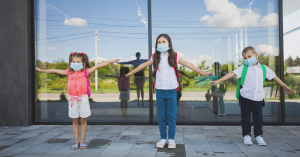Skin conditions in children can cause both medical and emotional distress, especially when they alter appearance. Vitiligo is one such condition where white patches develop on the skin due to the loss of pigment-producing cells called melanocytes. While vitiligo is not life-threatening or contagious, its visible effects can impact a child’s self-esteem. Understanding the condition can help parents support their children effectively.
What Is Vitiligo?
• Vitiligo is a chronic skin condition characterized by the development of white patches due to the destruction or malfunction of melanocytes.
• It can affect the skin, hair, and even mucous membranes inside the mouth and nose.
• The condition can start at any age, but about 25% of cases begin in childhood or adolescence.
Types of Vitiligo in Children
1. Non-Segmental Vitiligo (NSV):
• The most common type, often symmetrical, affecting both sides of the body.
• Patches commonly appear on the face, hands, knees, elbows, and around body openings (eyes, mouth, genitals).
2. Segmental Vitiligo (SV):
• Appears on one side of the body in a specific area.
• Often develops early in life and progresses for a year or two before stabilizing.
3. Focal Vitiligo:
• Limited to one or a few areas without following a clear pattern.
4. Universal Vitiligo:
• A rare type where more than 80% of the body loses pigmentation.
Causes of Vitiligo in Kids
The exact cause of vitiligo is not fully understood, but several factors may contribute:
Autoimmune Response:
• The immune system mistakenly attacks melanocytes, causing pigment loss.
• Often linked with other autoimmune diseases like thyroid disorders, type 1 diabetes, or alopecia areata.
Genetic Factors:
• Family history increases the risk. About 30% of children with vitiligo have a relative with the condition.
Neurogenic Factors:
• A connection between the nerves and melanocytes may trigger pigment loss.
Environmental Triggers:
• Sunburn, skin injury (known as the Koebner phenomenon), or emotional stress can trigger or worsen vitiligo in genetically susceptible children.
Oxidative Stress:
• Imbalance between free radicals and antioxidants in the body might damage melanocytes.
Signs and Symptoms of Vitiligo in Children
White Patches on the Skin:
• The hallmark sign, often first noticed on sun-exposed areas like the face, hands, feet, and arms.
• Patches are usually milky white with well-defined borders.
Premature Graying of Hair:
• Hair on the scalp, eyebrows, eyelashes, or beard (in older children) may turn white.
Mucosal Changes:
• Loss of pigment inside the mouth, nose, or on the lips.
Eye Changes:
• In rare cases, slight color changes in the retina or iris, but without affecting vision.
Koebner Phenomenon:
• New patches appear after skin injury, such as cuts, burns, or rashes.
How Is Vitiligo Diagnosed in Children?
A dermatologist usually diagnoses vitiligo based on:
Medical History:
• Family history of vitiligo, autoimmune diseases, recent illnesses, or skin injuries.
Physical Examination:
• A thorough skin check to assess the extent and pattern of depigmentation.
Wood’s Lamp Examination:
• A special ultraviolet light that highlights depigmented areas, even those not visible to the naked eye.
Blood Tests (if needed):
• To rule out associated autoimmune conditions like thyroid disorders, anemia, or diabetes.
Skin Biopsy (rarely needed):
• A small skin sample to rule out other conditions like fungal infections or pigment disorders.
How Is Vitiligo Different from Other Skin Conditions?
Tinea Versicolor:
• A fungal infection causing light patches, but often with slight scaling.
Pityriasis Alba:
• Common in children, presents as light patches with mild scaling, usually on the face.
Post-Inflammatory Hypopigmentation:
• Follows skin injury or inflammation, but the skin eventually regains color.
Albinism:
• A genetic condition causing widespread depigmentation from birth, unlike vitiligo, which develops later.
Treatment Options for Vitiligo in Children
While vitiligo has no permanent cure, treatments aim to restore skin color and stop the spread of patches. The choice depends on the child’s age, extent of the condition, and emotional impact.
1. Topical Treatments:
• Corticosteroid Creams:
• Reduce inflammation and may help repigment the skin, especially when started early.
• Long-term use requires caution due to side effects like thinning skin.
• Topical Calcineurin Inhibitors (Tacrolimus or Pimecrolimus):
• Effective for delicate areas like the face and neck.
• Fewer side effects compared to steroids.
2. Light Therapy (Phototherapy):
• Narrowband UVB Therapy:
• Safe and effective for children with widespread vitiligo.
• Requires multiple sessions per week under medical supervision.
• Excimer Laser:
• Targets small patches with focused UVB light.
3. Systemic Treatments (Rarely Used in Kids):
• Oral Steroids or Immunosuppressants:
• Reserved for rapidly spreading vitiligo when other treatments fail.
• Used with caution due to potential side effects.
4. Surgical Options (For Older Teens with Stable Vitiligo):
• Skin Grafting:
• Transferring healthy, pigmented skin to affected areas.
• Micropigmentation (Tattooing):
• Artificial pigment applied to small areas like lips.
5. Cosmetic Camouflage:
• Makeup or Self-Tanning Products:
• Temporarily cover white patches, boosting confidence in social situations.
Home Care Tips and Emotional Support
Sun Protection:
• Use sunscreen (SPF 30 or higher) to prevent sunburn and reduce contrast between normal and depigmented skin.
Avoid Skin Trauma:
• Minimize cuts, scrapes, or friction, which can trigger new patches.
Healthy Diet:
• No specific diet cures vitiligo, but a balanced diet supports overall skin health.
Emotional Support:
Talk to Your Child:
• Explain vitiligo in simple, reassuring language.
Build Confidence:
• Focus on strengths and talents unrelated to appearance.
Counseling or Support Groups:
• Connect with others facing similar challenges.
When to See a Doctor
• Rapidly spreading white patches
• Emotional distress related to appearance
• Signs of other autoimmune conditions (fatigue, unexplained weight changes, hair loss)
Prognosis and Long-Term Outlook
• Vitiligo is not life-threatening or contagious.
• Some children experience spontaneous repigmentation, especially on the face.
• The condition may stabilize or spread unpredictably.
• Early treatment can improve outcomes, both medically and emotionally.
Conclusion
Vitiligo in children, though medically harmless, can have a significant emotional impact. Early recognition, prompt treatment, and strong emotional support can help children live confidently. Parents play a crucial role in helping their child embrace their unique appearance while managing the condition effectively.








